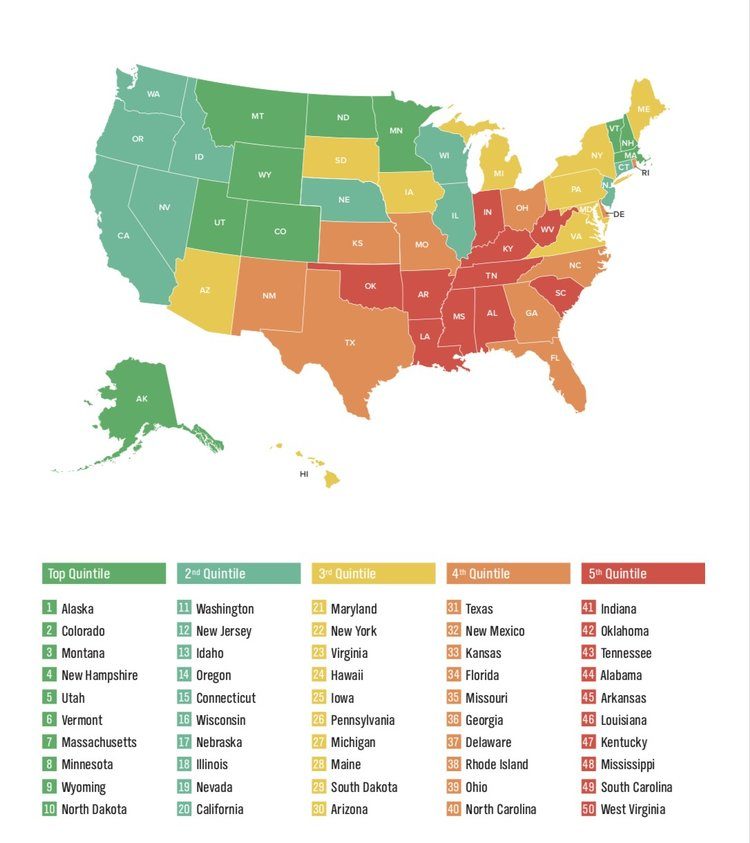
Prevalence of Diabetes by State, 2016–2017
A
new report on the continued alarming rise of diabetes in the U.S. illustrates how decades of government dietary guidance has thus far failed to contain this costly and debilitating disease.
As part of their
State of American Well-Being series, Gallup and Sharecare
found that 11.5% of the U.S. adult population was diagnosed with type 1 or type 2 diabetes in 2016-2017, up from 10.8% in 2008-2009.The survey, released this month, saw diabetes rates vary widely by state, from a low of 8.4% in Alaska to a startling 17.9% in West Virginia. Worse, obesity in the United States climbed 2.3 percentage points to 28.3% nationally.
This should be disturbing news to health and nutrition policy makers. For decades authorities have urged Americans to eat more grains and less fat, even though a mounting body of evidence shows that the exact opposite advice is more effective for reversing these diseases.Obesity, defined as a Body Mass Index (BMI) of 30 or greater, is a primary risk indicator for type 2 diabetes, the most common form of the disease. That correlation is clear in the Gallup-Sharecare survey. "States with a rising obesity rate are 2.3 times more likely to have a rising diabetes rate than are those that have a stable obesity rate," the report said.
For instance, West Virginia, the nation's leader in diabetes, also had the highest obesity rate, at 34.5%. Diabetes and obesity rates were also high in such southern states as Alabama, Arkansas, Louisiana, Mississippi and South Carolina. Only three states saw diabetes rates go up without seeing a concomitant increase in obesity.
The rising rate of diabetes is not only a healthcare crisis, it is a financial one.
As we reported in our latest newsletter, a recent analysis found that adults with type 2 diabetes spend $54,700 - $130,800 in medical expenses over their lifetime. That's more than twice what non-diabetics spend. In addition, the analysis found that the cost of diabetes to the U.S. economy in 2015 amounted to $322 billion, nearly twice the level in 2007.As a nation, we can arrest these unacceptable trends.
Breakthrough research has discovered that patients with type 2 diabetes can put their disease into remission by restricting carbohydrates. A large, ongoing university-based study found that 60% of patients with type 2 diabetes reversed their diagnosis after just one year on a very low-carb diet.
This new and promising science is
slowly entering the mainstream. The American Diabetes Association and the European Association for the Study of Diabetes recently
added the low-carb diet as a therapeutic option for diabetes patients. And in a crucial step forward,
the agencies that produce the U.S. Dietary Guidelines for Americans recently stated that the "low-carb diet" is among the topics selected for review by the next Dietary Guidelines Advisory Committee.
It's important to note that there are two other evidence-based ways to reverse type 2 diabetes: bariatric surgery and a very low-calorie diet (i.e., 800 calories per day). For Americans who are either pre-diabetic or diabetic, estimated now to be between
one third and
more than one half of the population, all three options should be presented as viable approaches supported by rigorous science.
Comment: Any sensible person should be able to look at the strategy of the government nutritional guidelines have been using for the past decades and see that they clearly are not working. But rather than look at the emerging science and adjust accordingly, the researchers continue to double down on the same old advice. Either people are going to wake up to the mess that are the dietary guidelines, or they're going to die. It's basically Darwinism.
See also: